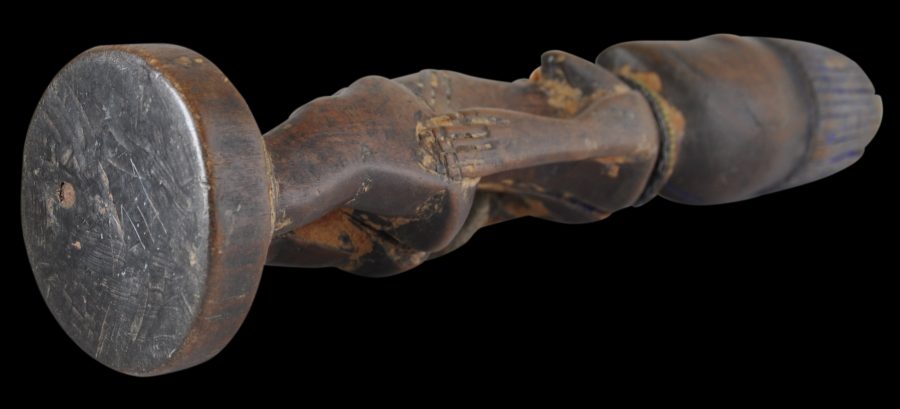Enquiry about object: 3498
Nigerian Yoruba Ibeji Twin Figure (Ere Ibeji)
Yagba Tribe, Egbe Region, Nigeria late 19th century
height: 25.5cm
Provenance
UK art market
This female Ere Ibeji figure, which has been carved from a single piece of light wood, has a superb patina from age and ritual use. The figure is taller than many ibeji figures and stands with the hands on the hips. Much of the detail of the face has been worn away from ritual caressing and stroking. The eyes however can be seen to have been wide-open and elliptical. The ears have been worn down to mere suggestions. Ere Ibeji figures represent a dead infant twin. However, like all such ibeji figures, this example is carved with mature or adult features, such as prominent breasts and a prominent pubic area.
The arms are elongated in relation to the legs. The buttocks are prominent.
Remains of scarifications can be seen on the cheeks, but that about the abdomen is still prominent.
The hair is cylindrical and rises vertically and fez-like from the head. It is worn but retains remnant of Rickett’s Blue.
The Ere Ibeji figure here is in fine condition with rounded contours from handling and use. It retains remnants oftukula powder in its crevices, which was applied to protect the image from insect damage and also out of a belief that it had healing or magical properties. There is some age and shrinkage related cracking but this is typical, stable and old. The figure has an old encrusted iron bracelet on one arm and two rows of unusually fine and colourful stripy trade glass beads around the necks. These too have a fine patina and are clearly very old.
Yoruba people have the highest dizygotic (non-identical) twinning rate in the world. The births of twins amongst Yoruba women are four times more likely than anywhere else in the world. Unfortunately, the mortality rate of the twins also is very high. Ere Ibeji figures were carved as spiritual representations of the twins who died. (Ere Ibeji is a combination of Yoruba words: ere ‘sacred image’, ibi ‘born’ and eji ‘two’.)These figures were commissioned from village carvers, who were also often highly trained priests (Babalawo). They images were carved as adults, rather than as the deceased infants. It is common in African sculpture that child features in carving are more mature, including elaborate coiffures, scarifications on the face, fully developed breasts (on female figures), pubic hair and prominent genitalia. They were usually placed on a shrine dedicated to Elegba (a divine messenger deity) in the living area of the house and fed, bathed and dressed regularly. These figures were particularly special to the mother, who kept them close to her and caressed the figures in a loving manner, hence the wear that genuinely old examples exhibit.
References
Bacquart, J. B., The Tribal Arts of Africa,Thames & Hudson, 1998.
Fagg, W. and J. Pemberton, J., Yoruba: Sculpture of West Africa, Collins, 1982.
Rowland, A., H.J. Drewal, and J. Pemberton, Yoruba: Art and Aesthetics,Museum Rietberg, Zurich, 1991.









